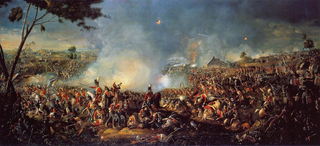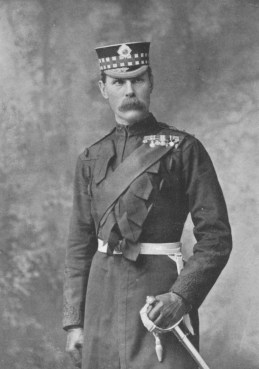
The Battle of Waterloo was fought on Sunday 18 June 1815, near Waterloo. A French army under the command of Napoleon was defeated by two of the armies of the Seventh Coalition. One of these was a British-led coalition consisting of units from the United Kingdom, the Netherlands, Hanover, Brunswick, and Nassau, under the command of the Duke of Wellington. The other was composed of three corps of the Prussian army under the command of Field Marshal von Blücher. The battle marked the end of the Napoleonic Wars. The battle was contemporaneously known as the Battle of Mont Saint-Jean (France) or La Belle Alliance.

The 1st Division is an infantry division of the British Army that has been formed and disestablished numerous times since 1809 and is still currently active as the 1st Division. Lieutenant-General Arthur Wellesley raised the division for service in the Peninsular War, which was part of the Coalition Wars of the Napoleonic Wars. The division was disestablished in 1814 but reformed the following year for service in the War of the Seventh Coalition. It then fought at the Battle of Waterloo, where it repulsed numerous attacks, including the final attack of the day that was launched by the French Imperial Guard. Following the battle, the division marched into France and became part of the Army of Occupation before being disbanded a few years later.

The 7th Infantry Division was an infantry division of the British Army, first established by The Duke of Wellington as part of the Anglo-Portuguese Army for service in the Peninsular War, and was active also during the First World War from 1914 to 1919, and briefly in the Second World War in 1939.
The Light Division was a light infantry division of the British Army. Its origins lay in "Light Companies" formed during the late 18th century, to move at speed over inhospitable terrain and protect a main force with skirmishing tactics. These units took advantage of then-new technology in the form of rifles, which allowed it to emphasise marksmanship, and were aimed primarily at disrupting and harassing enemy forces, in skirmishes before the main forces clashed.

Field Marshal John Byng, 1st Earl of Strafford was a British Army officer and politician. After serving as a junior officer during the French Revolutionary Wars and Irish Rebellion of 1798, he became Commanding Officer of the Grenadier Battalion of the 3rd Regiment of Foot Guards during the disastrous Walcheren Campaign. He served as a brigade commander at the Battle of Vitoria and then at the Battle of Roncesvalles on 25 July 1813 when his brigade took the brunt of the French assault and held its position for three hours in the early morning before finally being forced back.
General Sir John "Black Jack" Slade, 1st Baronet, served as a general officer in the British Army during the Peninsular War. Slade was praised in official reports, including by Arthur Wellesley, 1st Duke of Wellington, who also voiced some criticisms of him privately. Slade received an Army Gold Medal, and was honoured three times with the thanks of Parliament. Slade's descendants include two admirals, namely son Sir Adolphus Slade and grandson Sir Edmond Slade. Despite achieving high rank during and after active soldiering, Slade was criticised as a general of cavalry by some contemporaries and historians.

General Sir William Anson, 1st Baronet, was a British officer from the Anson family. He became a general in the British Army and noted for his service in the Peninsular War.

General Sir George Townshend Walker, 1st Baronet, GCB ComTE was a British Army officer. He joined the army in 1782, but after his first two regiments were quickly disbanded, he joined the 36th Regiment of Foot stationed in India in 1784. He returned to England in 1787 suffering from an illness, and became aide de camp to General Thomas Bruce in Ireland. After being promoted to captain lieutenant, Walker studied German and tactics in Germany until he was promoted to captain in the 60th Regiment of Foot in 1791. When the French Revolutionary War began in 1793, he took a force of volunteers to reinforce the Flanders Campaign, where he fought at the Battle of Tournay. He was appointed Inspector of Foreign Corps while serving on the continent, and as such helped form Roll's Regiment for British service. He took them to England in 1796, and having been promoted to major he went to serve in Portugal in 1797. Here Walker again served as an aide de camp, to at first Major-General Simon Fraser and then the Prince of Waldeck.
Lieutenant General George de Grey, 3rd Baron Walsingham was a British peer and Army officer.
Barnard Foord Bowes or Barnard Bowes Foord commanded a British brigade in several battles during the Peninsular War. He joined the 26th Foot Regiment as a junior officer in 1781 and rose in rank by purchase to become lieutenant colonel of the 6th Foot Regiment in 1796. He led troops during the Irish Rebellion of 1798. From 1799 to 1806 he served in Canada and married his wife there. He led a brigade at Roliça and Vimeiro in 1808. He was promoted major general in 1810. He was severely wounded while leading his brigade in an assault during the 1812 Siege of Badajoz. He was killed in action leading a storming column at the Siege of the Salamanca Forts.
General Christopher Chowne, born Christopher Tilson and also known as Christopher Tilson-Chowne, was a British Army officer most notable for his service in the Peninsular War. He joined the army in 1788 and after periods of service in the 23rd Regiment of Foot and an Independent Company, he became lieutenant-colonel of the 99th Regiment of Foot in 1794. The 99th were disbanded in 1797, and Chowne joined instead the 44th Regiment of Foot in 1799. He commanded the regiment at the battles of Abukir and Mandora in the British campaign in Egypt in 1801. In 1805 he was appointed a brigadier-general, as which he served in the Anglo-Russian occupation of Naples later in the year and subsequently in the West Indies.






